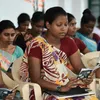Women unemployment rate falls to 4.2pc in 2019-20
Unemployment rate for women has come down from 5.1 percent in 2018-19 to 4.2 percent in 2019-20, according to a labour ministry statement.
Unemployment rate for women fell to 4.2 percent in 2019-20 from 5.1 percent in 2018-19, according to Periodic Labour Force Survey (PLFS) conducted by National Statistical Office (NSO). The NSO is a wing of the Ministry of Statistics and Programme Implementation.
"Unemployment rate for women has come down from 5.1 percent in 2018-19 to 4.2 percent in 2019-20," a labour ministry statement said.
As per the PLFS for 2019-20, of the total employment generated (in person days) in the 2020-21 under MGNREGS, women's share has increased to around 207 crore person days.
The Labour Force Participation Rate (LFPR) for women has increased from 24.5 percent in 2018-19 to 30.0 percent in 2019-20.
According to the statement, the findings of the survey were informed by Minister of State for Labour and Employment Rameshwar Teli in a written reply in the Lok Sabha on Monday.
The government has taken several initiatives to improve women's participation in the labour force. In order to encourage employment of women, a number of protective provisions have been incorporated in the labour laws for creating congenial work environment for women workers.
These include enhancement in paid maternity leave from 12 weeks to 26 weeks, provision for mandatory creche facility in the establishments having 50 or more employees, permitting women workers in the night shifts with adequate safety measures, etc.
The government has also taken a decision to allow the employment of women in the aboveground mines including opencast workings between 7 pm and 6 am and in below ground working between 6 am and 7 pm in technical, supervisory, and managerial work where continuous presence may not be required.
Further, in order to enhance the employability of female workers, the government is providing training to them through a network of Women Industrial Training institutes, National Vocational Training Institutes and Regional Vocational Training Institutes.
The government has taken various steps for generating employment in the country like encouraging various projects involving substantial investment and increasing public expenditure on schemes like Prime Minister's Employment Generation Programme (PMEGP), Mahatma Gandhi National Rural Employment Guarantee Scheme (MGNREGS), Pt. DeenDayal Upadhyaya Grameen Kaushalya Yojana (DDU-GKY) and Deendayal Antodaya Yojana-National Urban Livelihoods Mission (DAY-NULM).
Aatmanirbhar Bharat Rozgar Yojna (ABRY) Scheme has been launched with effect from 1st October 2020 to incentivise creation of new employment along with social security benefits and restoration of loss of employment. This scheme reduces the financial burden of the employers and encourages them to hire more workers.
Under ABRY, the Government of India is providing for a period of two years both the employees' share (12 percent of wages) and employer's share (12 percent of wages) of contribution payable or only the employees' share, depending on employment strength of the EPFO registered establishments.
The new employees under the scheme include those who lost their jobs during Covid-19 and didn't join in any EPF covered establishment up to September 30, 2020.
The terminal date for registration of beneficiary under the scheme has been extended from June 30, 2021, to March 31, 2022.
As on July 12, 2021, total benefit of around Rs 993 crore has been given through 84,390 establishments covering more than 22 lakh beneficiaries including 5.88 lakh women beneficiaries.
The government is incentivising employers for the creation of new employment with social security benefits. Under the scheme, Government of India is paying Employer's full contribution i.e. 12 percent towards EPF and EPS both (as admissible from time to time) for a period of three years to the new employees through EPFO.
The terminal date for registration of beneficiary through establishment was March 31, 2019. The beneficiaries registered up to March 31, 2019 will continue to receive the benefits for three years from the date of registration under the scheme.
Under PMRPY, as of June 14, 2021, benefits have been given to 1.21 crore beneficiaries, including 26.05 lakh women beneficiaries.
Pradhan Mantri Mudra Yojana (PMMY) has been initiated by the government inter alia, for facilitating self-employment. Under PMMY collateral free loans up to Rs 10 lakh, are extended to micro/small business enterprises and to individuals to enable them to setup or expand their business activities. About 70 percent of the loans have been given to women entrepreneurs.
The government has increased MGNREGA wage to Rs 202 a day from Rs 182 to benefit nearly 13.62 crore families.
Out of total employment generated (in person days) under MGNREGS, women share has increased from around 145.35 crore person days in FY 2019-20 to around 207 crore person days in the FY 2020-21.
Edited by Megha Reddy




![[100 Emerging Women Leaders] How this woman braved domestic violence and abuse to find her niche as a fitness trainer](https://images.yourstory.com/cs/4/a9efa9c02dd911e9adc52d913c55075e/Imagexxli-1627391299237.jpg?fm=png&auto=format&h=100&w=100&crop=entropy&fit=crop)




